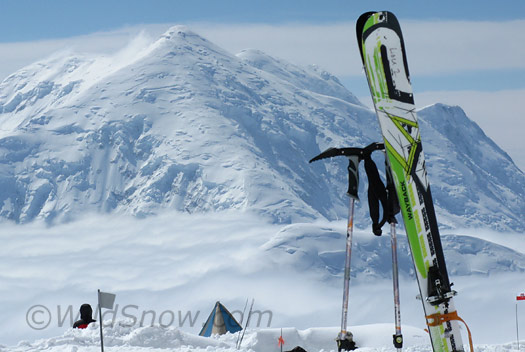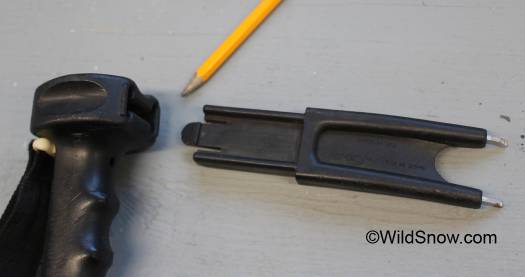
Whippets on Denali, Foraker in background.
Whippet Self Arrest Ski Pole Grips
If I had to choose Black Diamond’s #1 contribution to our sport, I’d go with ski poles. Dilemma is do I go with the Whippet self arrest grip or FlickLock adjustment clamp? Since most people using Flick-lock poles never use the lock past their initial length adjustment (even though it works well), I’ll give the Whippet 1st place. If equipped with Whippet grips in alpine terrain, you’ll find yourself constantly using them, seemingly by instinct. It’s like they become an extension of your hands.
Ski pole self arrest grips (help stop a fall down steep snow) have been around forever. But prior to the retail introduction of Whippet in 1996, most (if not all) offerings were about as good as using a toothpick to hook a shark. The Ramer Claw was one of the first. While somewhat effective, it was bulky and constructed entirely of plastic, thus lacking mass and penetration in harder snow. Another company, Gipron, sold a ski pole grip with a removable self-arrest prong, which Black Diamond distributed. The Gipron simply was not strong enough nor the correct shape.
Industrial designer Andrew McLean changed all that. In 1995 he was working for Black Diamond as a product designer, and doing quite a bit of steep skiing. He wanted arrest grips that were effective, so he worked on his own ideas as a “skunk works after hours” project that eventually became a BD product.

Gipron self arrest grip was made in Italy, innovative in that the blade was removable. Unfortunately they were weak and the shape of the pick wasn’t effective.

Gipron with blade removed. In the 1990s I got quite used to removing and attaching the blades when needed, so it took me years to get used to the fixed Whippet. Now I see the genius of Andrew’s approach, which is basically less fiddling and always having the tool at hand. Caveat, do use the tip protectors supplied with the Whippet if you don’t feel you need the sharp.
Andrew told me that due to the limitations of the Ramer and Gipron, he and others were skiing with an ice axe. Doing so was awkward and perhaps even dangerous due to the challenge of controlling a large tool with two sharp sides. “I mounted an ice axe head on a ski pole,” Andrew said, “and the adze dug into my wrist while making pole plants, so I ground off the adze then began grinding down the axe pick until it was the right size for skiing.” Andrew added the flange on the pick so it had more resistance during self arrest in soft snow, eventually proposing the product at a BD sales meeting. The Whippet required no tooling as it was laser cut, so cost of entry was low and Black Diamond went for it.
Whippet grips have since become a defacto standard of ski alpinism, used as much as a climbing aid as a safety device. (Grivel also makes a spike grip, with a folding pick, they’re bulky but worth considering as well.) It should be said that once you’re moving down steep terrain and take a fall, even an ice-axe can be minimally effective — and Whippets less so. More, it’s worth reminding ourselves to avoid any sense of false security that you could succumb to while sporting these tools. Nonetheless, the McLean Whippet has doubtless saved hundreds of lives including those of this writer’s closest friends and family members. What kudos for a product designer, to actually save a life!
Check out Andrew’s design portfolio.
Ascension Climbing Skins
In the early 1990s and before, we were stuck with climbing skins from Europe, mainly, Coltex. In cold North American conditions, Coltex glue stuck about as well as a Post-it note covered with dandruff, and wore out as fast. Black Diamond bought Ascension in 1999 from Ascension Enterprises, the guys who formulated a super-sticky glue and sourced a nylon conveyor-belt plush that climbed like a monkey. Ascension Enterprises also innovated retail and DIY skin trimming for shaped skis, and worked hard on innovating better plush and tail attachment systems. Thankfully the original Ascension philosophy of sticky glue and ultra-grippy plush still provides fans of steep skinning with the tools they need for their craft. Kudos, BD has kept the faith and still sells what we’ve always called the “Orange Ascension,” as always optimized for grip. If you want ultimate durability and traction, look no farther.
Diamir Fritschi Bindings
Despite our lumping frame bindings with outdated technology such as carbureted engines and dial telephones, one must give credit where credit is due. The “plate on a hinge” way of creating a working touring binding was where virtually all innovation happened up to about 1987 when Fritz Barthel began retailing his tech binding invention. So, many years B.F. (before Fritz), Chouinard Equipment’s Yvon Chouinard worked with Paul Parker and others to import alpine touring gear from Europe. My recollection is their first effort was to bring in the Salewa — a problematic frame binding that you couldn’t ski without accidental ejection unless you essentially locked out all your release.
In 1995 Black Diamond began partnering with Fritschi to do North American distribution of the first model Diamir. While the binding was not without hiccups, it was in my opinion the first truly “modern” frame binding in that it incorporated an alpine style heel and a faux alpine toe. The Diamir thus showed North American skiers that yes, it-just-might-be-possible to have a touring binding that was an alpine resort binding. The rest is history.
Much could be made of other BD innovations over the years. I especially like how they’ve kept at it with skis, morphing from telemark touring in the early days, to a brief attempt at being an alpine ski company (that was interesting, to put it mildly), and now back to a solid line of core backcountry planks — Carbon Convert is still the apex. I tried to dredge up memories of exactly when Black Diamond began selling their own branded skis, rather than the Tua brand they sold in the old days. Near as I could glean, they began having the branded skis made by Atomic in 1990. One of the best of the early BD branded skis was the Mira, a lightweight cap constructed ski with a 78 mm waist. Amazingly, if you google the Mira you’ll still find some that are ostensibly for sale more than 20 years later!
We should shout out the Jetforce avalanche airbag project as well. The “fan ballon.” I’d imagine Jetforce was ridiculously expensive to develop, but at the same time I’m certain it is revolutionary.
It’s no secret that Black Diamond is going through changes these days. The details are complex and I’m not a financial analyst. Suffice it to say that in our opinion the BD brand is still incredible, and if they look at their history and stick with their roots they’ll do fine. And no, they don’t need to make ski boots to be a ski touring company.
Oh, and here is our requisite shopping link, this time for Whippet.
WildSnow.com publisher emeritus and founder Lou (Louis Dawson) has a 50+ years career in climbing, backcountry skiing and ski mountaineering. He was the first person in history to ski down all 54 Colorado 14,000-foot peaks, has authored numerous books about about backcountry skiing, and has skied from the summit of Denali in Alaska, North America’s highest mountain.

